Responsible Alcohol Consumption and Health: Indigenous Australians
VerifiedAdded on 2023/06/04
|13
|1226
|110
Presentation
AI Summary
This presentation delves into the critical issue of responsible alcohol consumption, with a specific focus on the indigenous populations of Australia. It highlights the disproportionately high rates of alcohol consumption among Aboriginal and Torres Strait Islander peoples compared to non-indigenous individuals, citing statistical data to emphasize the severity of the problem. The presentation utilizes the Red Lotus Health and Wellbeing Model to analyze the various factors influencing health outcomes, including biological and socioeconomic statuses, environmental determinants, and the need for appropriate healthcare systems and educational facilities. The study also discusses the challenges encountered during implementation, such as language barriers and cultural insensitivity, and emphasizes the need for culturally competent interventions. The conclusion stresses the importance of modifying strategies based on encountered challenges, providing enhanced healthcare opportunities, and promoting responsible alcohol usage to reduce mortality rates and improve overall health outcomes within the indigenous communities. The presentation concludes with a comprehensive list of references.
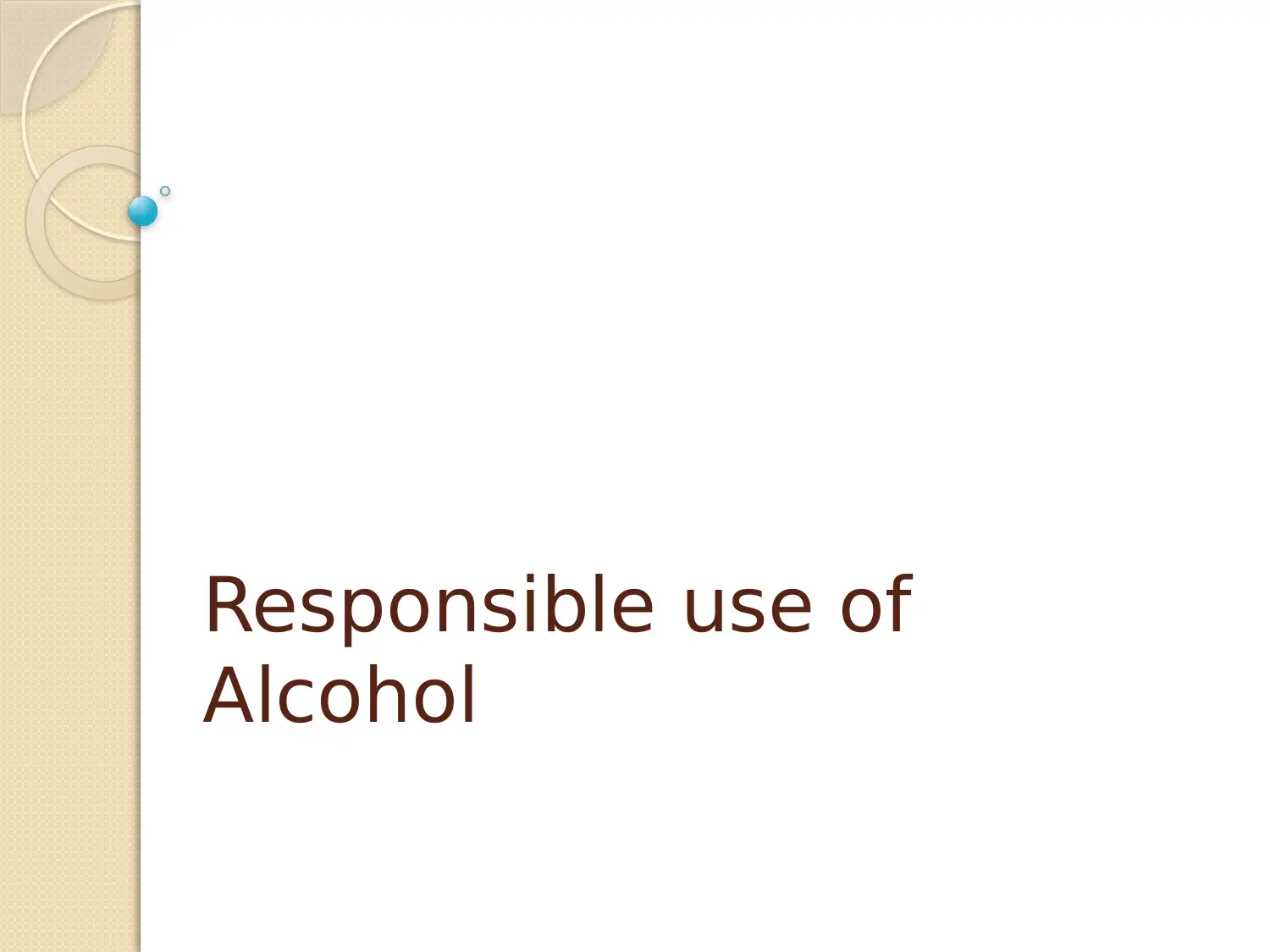
Responsible use of
Alcohol
Alcohol
Paraphrase This Document
Need a fresh take? Get an instant paraphrase of this document with our AI Paraphraser

Introduction
it has been found that the
degree of consumption of
alcohol to a tremendous level
higher among aboriginal as well
as Torres islander compared to
that of the non-indigenous
individuals
According to survey more than
57.3 percent of the indigenous
population is prone to over
consumption of alcohol
In this presentation a detailed
analysis of the responsible
alcoholic consumption of both
indigenous as well as non-
indigenous people of Australia
has been discussed (5).
it has been found that the
degree of consumption of
alcohol to a tremendous level
higher among aboriginal as well
as Torres islander compared to
that of the non-indigenous
individuals
According to survey more than
57.3 percent of the indigenous
population is prone to over
consumption of alcohol
In this presentation a detailed
analysis of the responsible
alcoholic consumption of both
indigenous as well as non-
indigenous people of Australia
has been discussed (5).
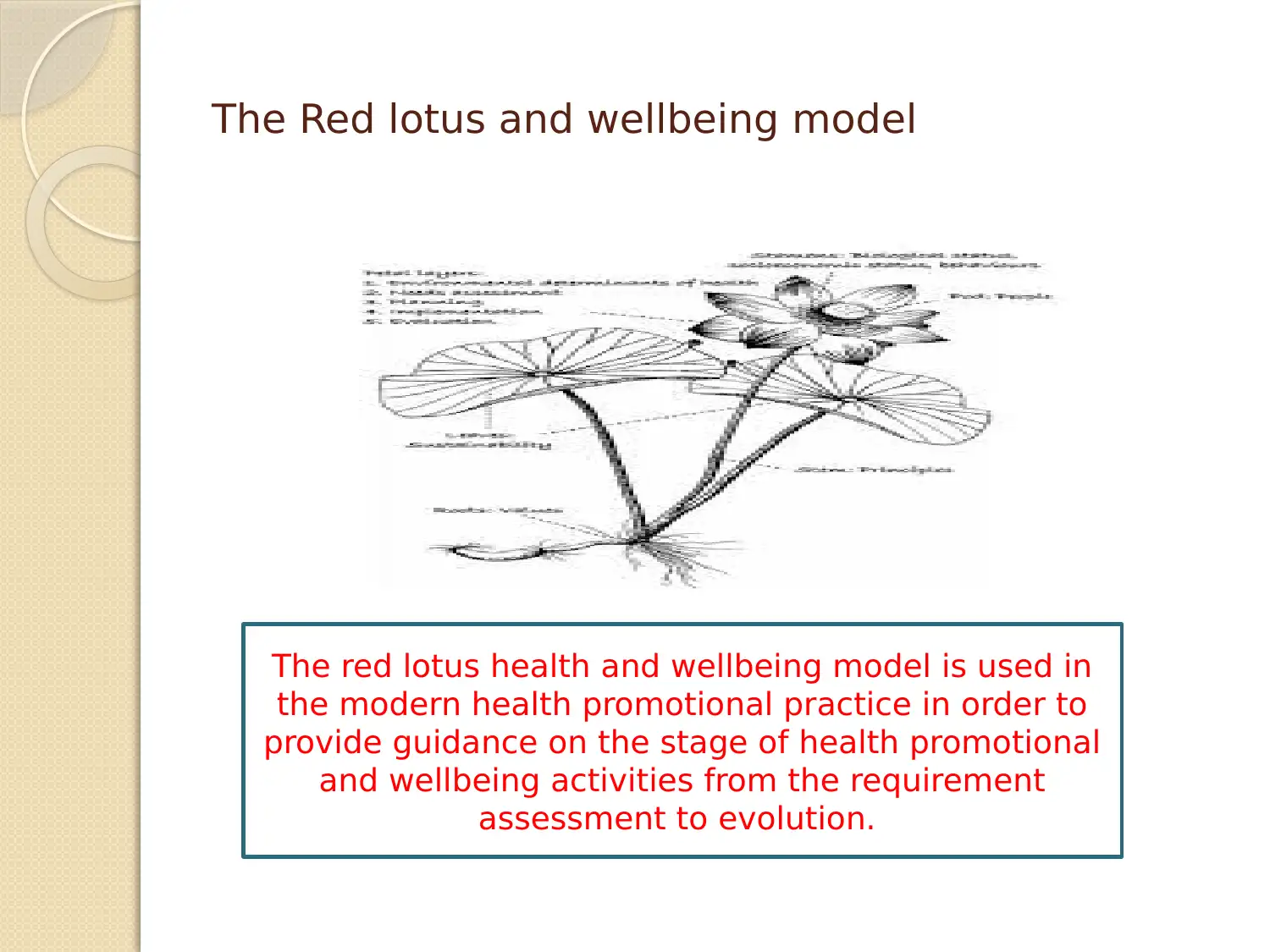
The Red lotus and wellbeing model
The red lotus health and wellbeing model is used in
the modern health promotional practice in order to
provide guidance on the stage of health promotional
and wellbeing activities from the requirement
assessment to evolution.
The red lotus health and wellbeing model is used in
the modern health promotional practice in order to
provide guidance on the stage of health promotional
and wellbeing activities from the requirement
assessment to evolution.
⊘ This is a preview!⊘
Do you want full access?
Subscribe today to unlock all pages.

Trusted by 1+ million students worldwide
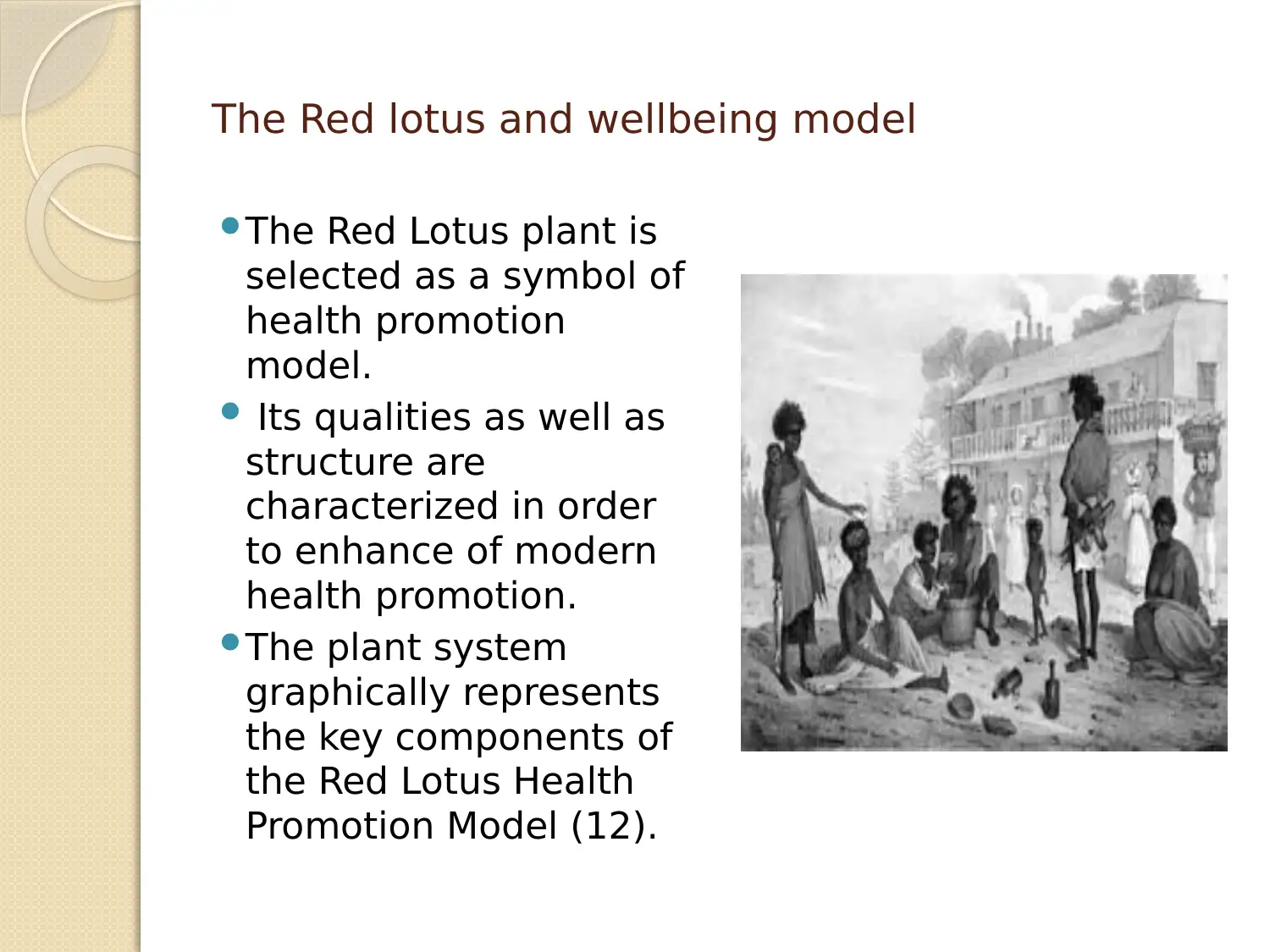
The Red lotus and wellbeing model
The Red Lotus plant is
selected as a symbol of
health promotion
model.
Its qualities as well as
structure are
characterized in order
to enhance of modern
health promotion.
The plant system
graphically represents
the key components of
the Red Lotus Health
Promotion Model (12).
The Red Lotus plant is
selected as a symbol of
health promotion
model.
Its qualities as well as
structure are
characterized in order
to enhance of modern
health promotion.
The plant system
graphically represents
the key components of
the Red Lotus Health
Promotion Model (12).
Paraphrase This Document
Need a fresh take? Get an instant paraphrase of this document with our AI Paraphraser
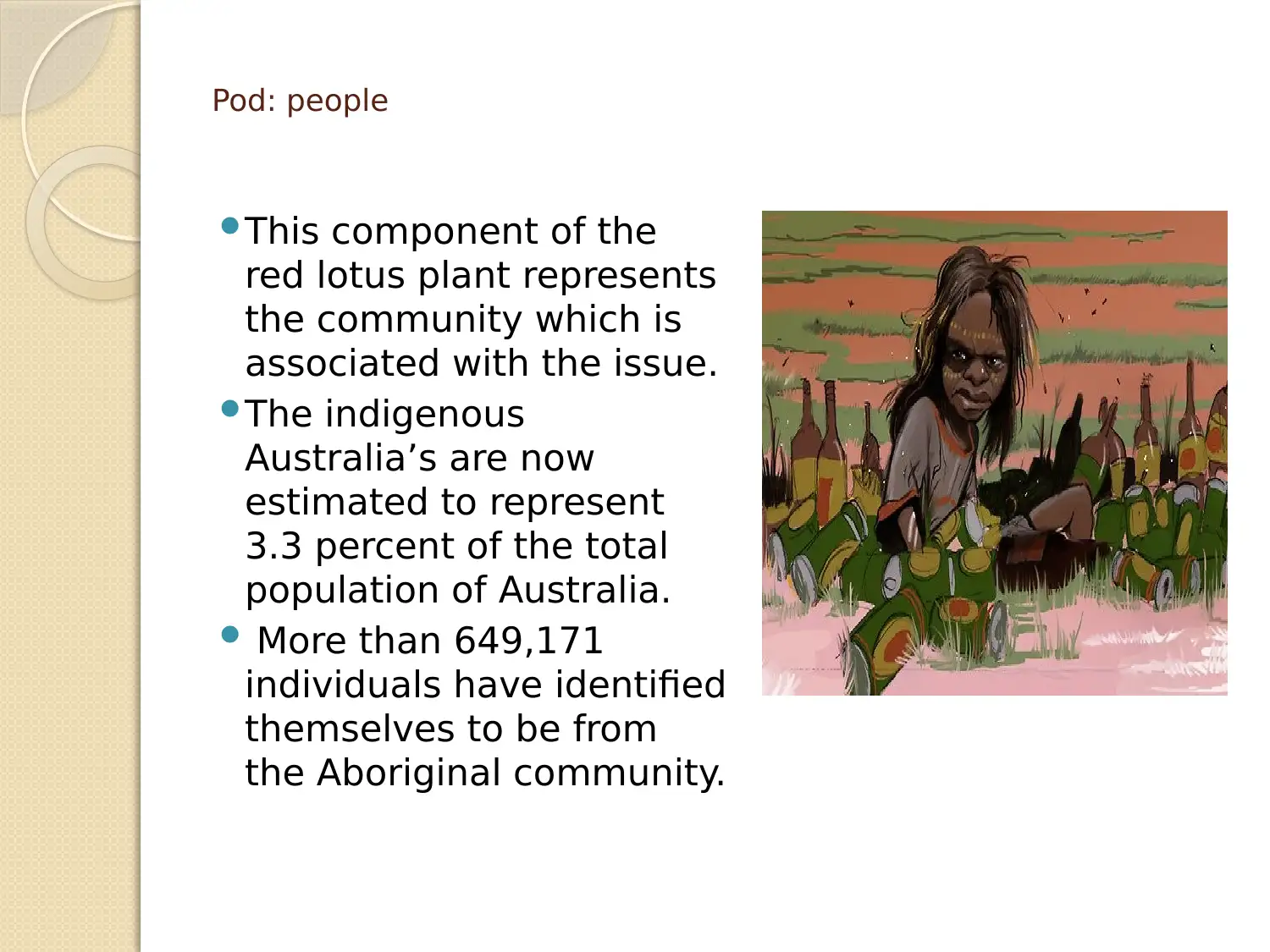
Pod: people
This component of the
red lotus plant represents
the community which is
associated with the issue.
The indigenous
Australia’s are now
estimated to represent
3.3 percent of the total
population of Australia.
More than 649,171
individuals have identified
themselves to be from
the Aboriginal community.
This component of the
red lotus plant represents
the community which is
associated with the issue.
The indigenous
Australia’s are now
estimated to represent
3.3 percent of the total
population of Australia.
More than 649,171
individuals have identified
themselves to be from
the Aboriginal community.

Stamen: Biological status, socio-economic status, behaviors
The stamen
represents the
characteristics of the
individuals that
interact with the
environmental
conditions to
determine health
outcomes
the aboriginal
community lacks
economic stability
(15)
The stamen
represents the
characteristics of the
individuals that
interact with the
environmental
conditions to
determine health
outcomes
the aboriginal
community lacks
economic stability
(15)
⊘ This is a preview!⊘
Do you want full access?
Subscribe today to unlock all pages.

Trusted by 1+ million students worldwide
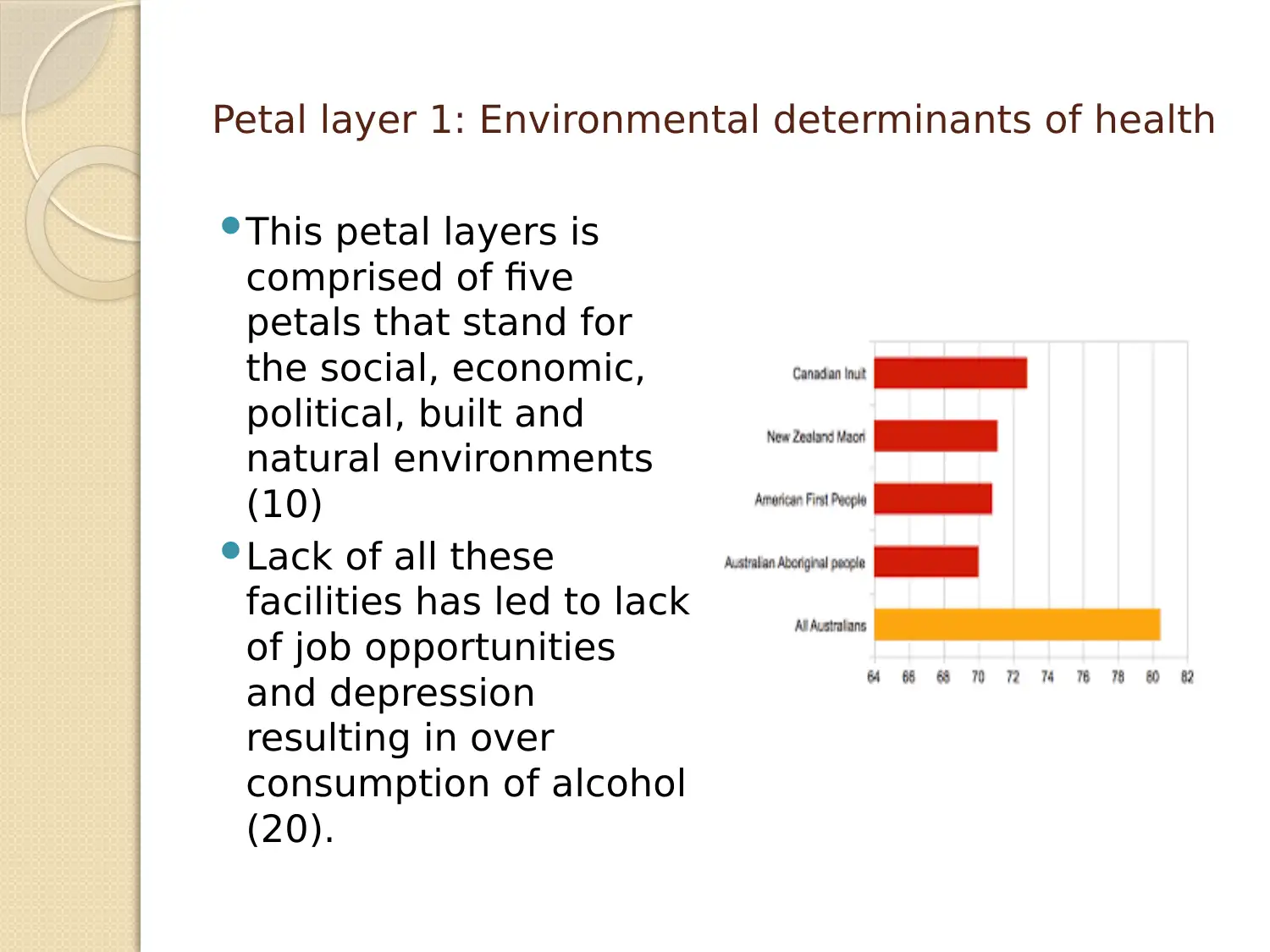
Petal layer 1: Environmental determinants of health
This petal layers is
comprised of five
petals that stand for
the social, economic,
political, built and
natural environments
(10)
Lack of all these
facilities has led to lack
of job opportunities
and depression
resulting in over
consumption of alcohol
(20).
This petal layers is
comprised of five
petals that stand for
the social, economic,
political, built and
natural environments
(10)
Lack of all these
facilities has led to lack
of job opportunities
and depression
resulting in over
consumption of alcohol
(20).
Paraphrase This Document
Need a fresh take? Get an instant paraphrase of this document with our AI Paraphraser

Petal layer 2: This layer is
consisting of 3 layers
It can be clearly
understood that
the first
requirement of
the indigenous
people includes
appropriate
healthcare system
so that the
disease caused
due too alcohol
consumption can
be prevented (9).
consisting of 3 layers
It can be clearly
understood that
the first
requirement of
the indigenous
people includes
appropriate
healthcare system
so that the
disease caused
due too alcohol
consumption can
be prevented (9).

Petal layer 3: Planning and Petal
layer 4: Implementation
in order to develop
their literacy rate,
educational
facilities should be
provided to them.
While implementing
the step, the chief
barrier that was
faced includes the
lack of language
competencies (6).
layer 4: Implementation
in order to develop
their literacy rate,
educational
facilities should be
provided to them.
While implementing
the step, the chief
barrier that was
faced includes the
lack of language
competencies (6).
⊘ This is a preview!⊘
Do you want full access?
Subscribe today to unlock all pages.

Trusted by 1+ million students worldwide
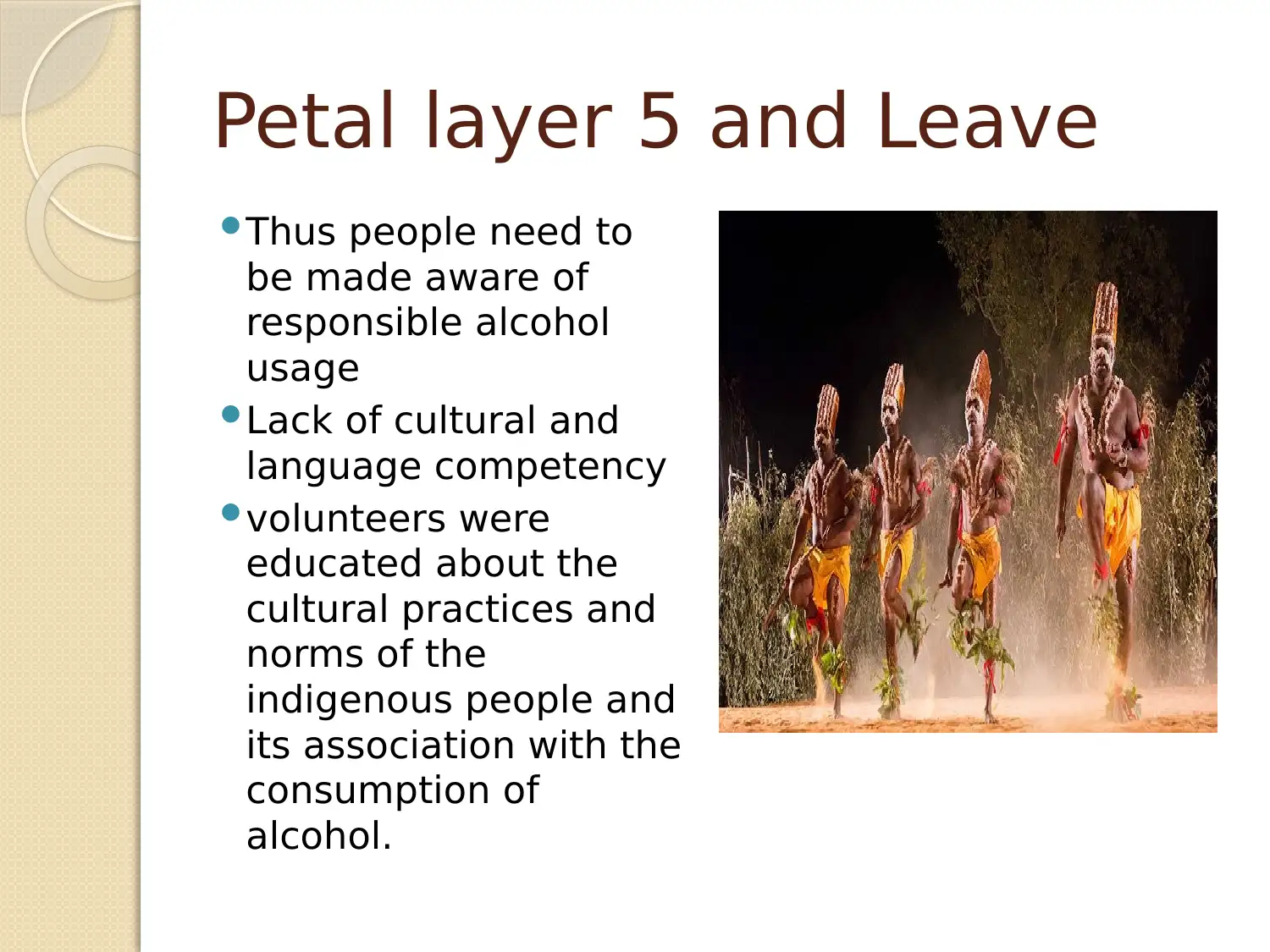
Petal layer 5 and Leave
Thus people need to
be made aware of
responsible alcohol
usage
Lack of cultural and
language competency
volunteers were
educated about the
cultural practices and
norms of the
indigenous people and
its association with the
consumption of
alcohol.
Thus people need to
be made aware of
responsible alcohol
usage
Lack of cultural and
language competency
volunteers were
educated about the
cultural practices and
norms of the
indigenous people and
its association with the
consumption of
alcohol.
Paraphrase This Document
Need a fresh take? Get an instant paraphrase of this document with our AI Paraphraser
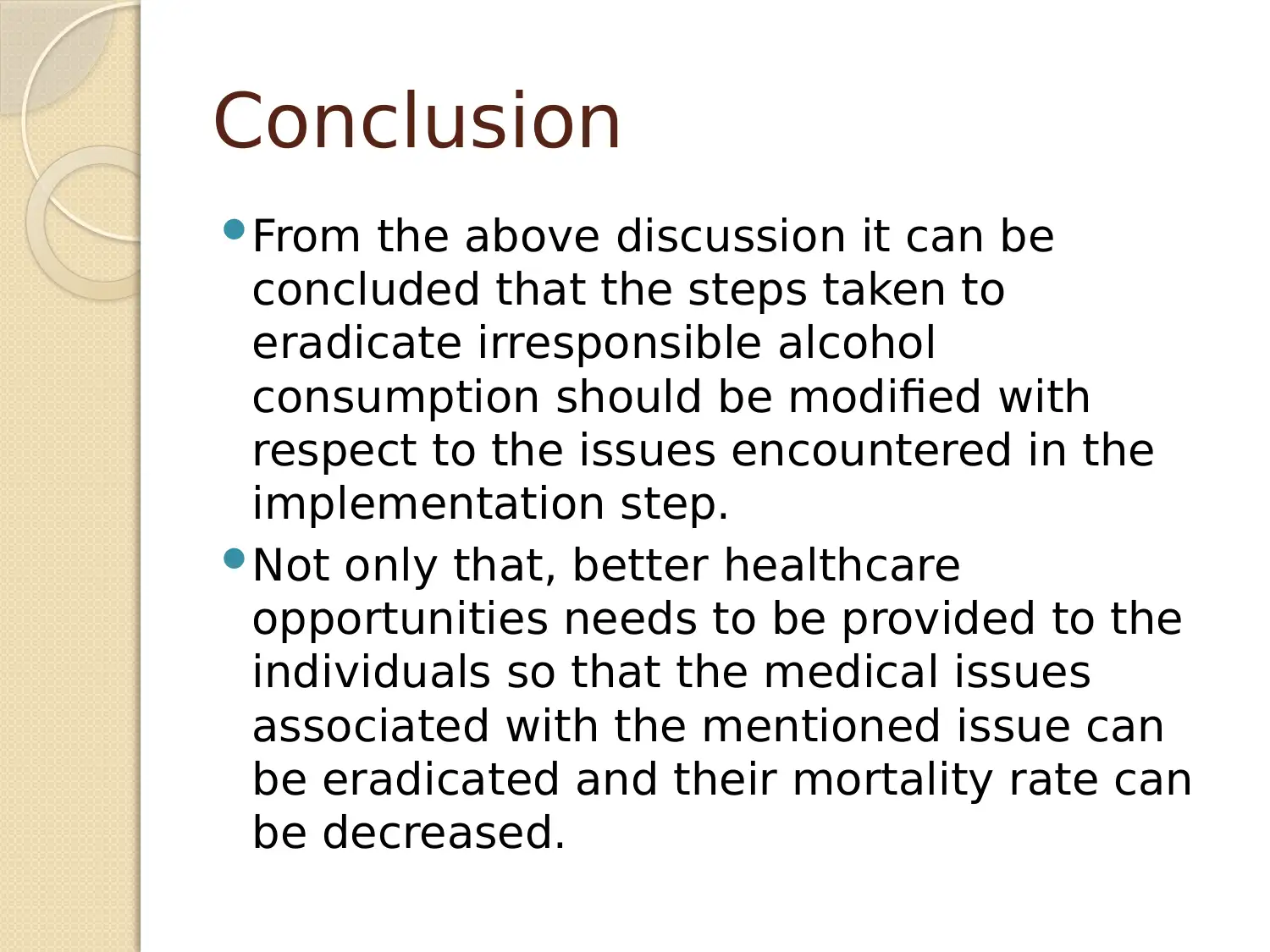
Conclusion
From the above discussion it can be
concluded that the steps taken to
eradicate irresponsible alcohol
consumption should be modified with
respect to the issues encountered in the
implementation step.
Not only that, better healthcare
opportunities needs to be provided to the
individuals so that the medical issues
associated with the mentioned issue can
be eradicated and their mortality rate can
be decreased.
From the above discussion it can be
concluded that the steps taken to
eradicate irresponsible alcohol
consumption should be modified with
respect to the issues encountered in the
implementation step.
Not only that, better healthcare
opportunities needs to be provided to the
individuals so that the medical issues
associated with the mentioned issue can
be eradicated and their mortality rate can
be decreased.
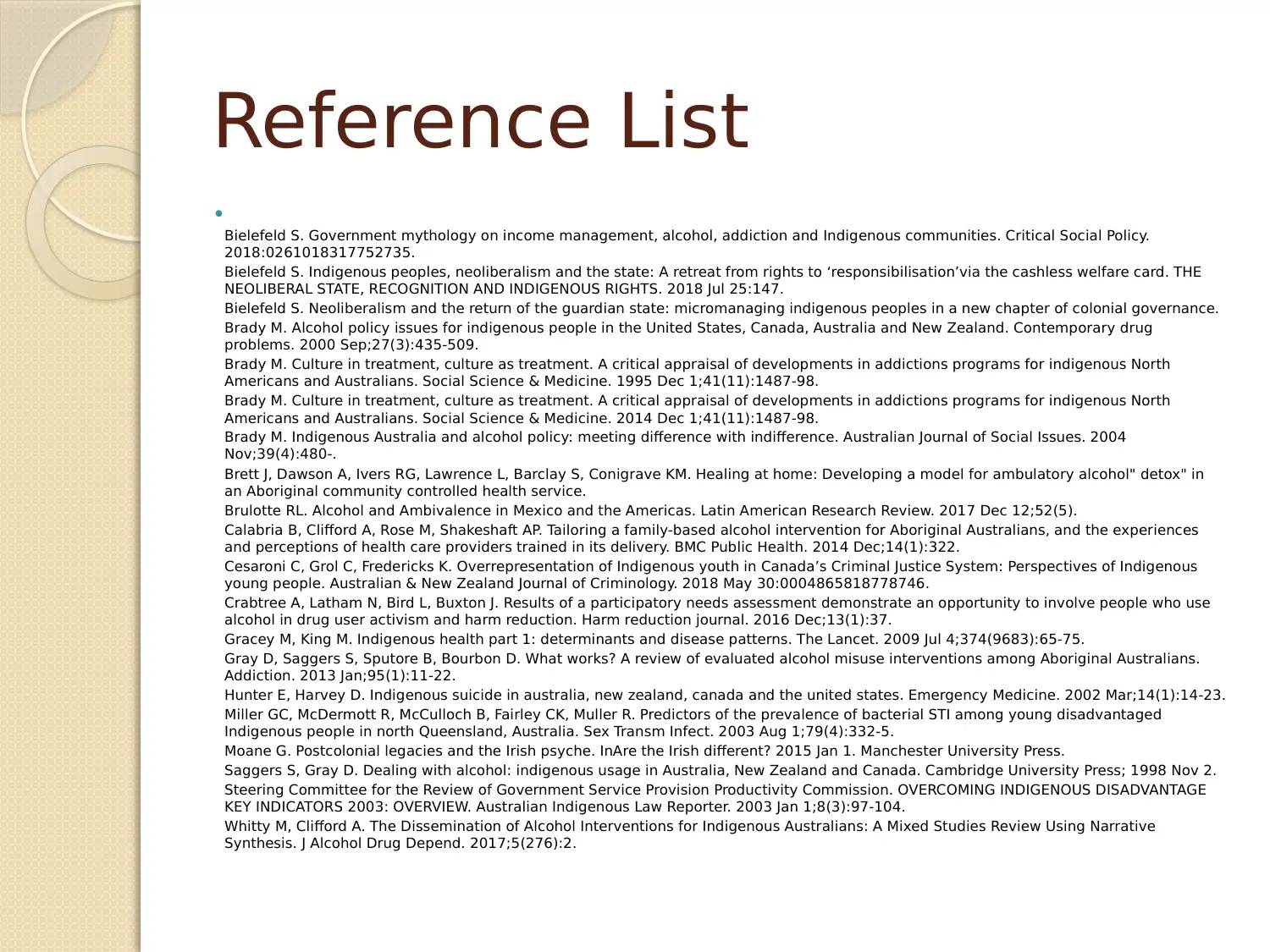
Reference List
Bielefeld S. Government mythology on income management, alcohol, addiction and Indigenous communities. Critical Social Policy.
2018:0261018317752735.
Bielefeld S. Indigenous peoples, neoliberalism and the state: A retreat from rights to ‘responsibilisation’via the cashless welfare card. THE
NEOLIBERAL STATE, RECOGNITION AND INDIGENOUS RIGHTS. 2018 Jul 25:147.
Bielefeld S. Neoliberalism and the return of the guardian state: micromanaging indigenous peoples in a new chapter of colonial governance.
Brady M. Alcohol policy issues for indigenous people in the United States, Canada, Australia and New Zealand. Contemporary drug
problems. 2000 Sep;27(3):435-509.
Brady M. Culture in treatment, culture as treatment. A critical appraisal of developments in addictions programs for indigenous North
Americans and Australians. Social Science & Medicine. 1995 Dec 1;41(11):1487-98.
Brady M. Culture in treatment, culture as treatment. A critical appraisal of developments in addictions programs for indigenous North
Americans and Australians. Social Science & Medicine. 2014 Dec 1;41(11):1487-98.
Brady M. Indigenous Australia and alcohol policy: meeting difference with indifference. Australian Journal of Social Issues. 2004
Nov;39(4):480-.
Brett J, Dawson A, Ivers RG, Lawrence L, Barclay S, Conigrave KM. Healing at home: Developing a model for ambulatory alcohol" detox" in
an Aboriginal community controlled health service.
Brulotte RL. Alcohol and Ambivalence in Mexico and the Americas. Latin American Research Review. 2017 Dec 12;52(5).
Calabria B, Clifford A, Rose M, Shakeshaft AP. Tailoring a family-based alcohol intervention for Aboriginal Australians, and the experiences
and perceptions of health care providers trained in its delivery. BMC Public Health. 2014 Dec;14(1):322.
Cesaroni C, Grol C, Fredericks K. Overrepresentation of Indigenous youth in Canada’s Criminal Justice System: Perspectives of Indigenous
young people. Australian & New Zealand Journal of Criminology. 2018 May 30:0004865818778746.
Crabtree A, Latham N, Bird L, Buxton J. Results of a participatory needs assessment demonstrate an opportunity to involve people who use
alcohol in drug user activism and harm reduction. Harm reduction journal. 2016 Dec;13(1):37.
Gracey M, King M. Indigenous health part 1: determinants and disease patterns. The Lancet. 2009 Jul 4;374(9683):65-75.
Gray D, Saggers S, Sputore B, Bourbon D. What works? A review of evaluated alcohol misuse interventions among Aboriginal Australians.
Addiction. 2013 Jan;95(1):11-22.
Hunter E, Harvey D. Indigenous suicide in australia, new zealand, canada and the united states. Emergency Medicine. 2002 Mar;14(1):14-23.
Miller GC, McDermott R, McCulloch B, Fairley CK, Muller R. Predictors of the prevalence of bacterial STI among young disadvantaged
Indigenous people in north Queensland, Australia. Sex Transm Infect. 2003 Aug 1;79(4):332-5.
Moane G. Postcolonial legacies and the Irish psyche. InAre the Irish different? 2015 Jan 1. Manchester University Press.
Saggers S, Gray D. Dealing with alcohol: indigenous usage in Australia, New Zealand and Canada. Cambridge University Press; 1998 Nov 2.
Steering Committee for the Review of Government Service Provision Productivity Commission. OVERCOMING INDIGENOUS DISADVANTAGE
KEY INDICATORS 2003: OVERVIEW. Australian Indigenous Law Reporter. 2003 Jan 1;8(3):97-104.
Whitty M, Clifford A. The Dissemination of Alcohol Interventions for Indigenous Australians: A Mixed Studies Review Using Narrative
Synthesis. J Alcohol Drug Depend. 2017;5(276):2.
Bielefeld S. Government mythology on income management, alcohol, addiction and Indigenous communities. Critical Social Policy.
2018:0261018317752735.
Bielefeld S. Indigenous peoples, neoliberalism and the state: A retreat from rights to ‘responsibilisation’via the cashless welfare card. THE
NEOLIBERAL STATE, RECOGNITION AND INDIGENOUS RIGHTS. 2018 Jul 25:147.
Bielefeld S. Neoliberalism and the return of the guardian state: micromanaging indigenous peoples in a new chapter of colonial governance.
Brady M. Alcohol policy issues for indigenous people in the United States, Canada, Australia and New Zealand. Contemporary drug
problems. 2000 Sep;27(3):435-509.
Brady M. Culture in treatment, culture as treatment. A critical appraisal of developments in addictions programs for indigenous North
Americans and Australians. Social Science & Medicine. 1995 Dec 1;41(11):1487-98.
Brady M. Culture in treatment, culture as treatment. A critical appraisal of developments in addictions programs for indigenous North
Americans and Australians. Social Science & Medicine. 2014 Dec 1;41(11):1487-98.
Brady M. Indigenous Australia and alcohol policy: meeting difference with indifference. Australian Journal of Social Issues. 2004
Nov;39(4):480-.
Brett J, Dawson A, Ivers RG, Lawrence L, Barclay S, Conigrave KM. Healing at home: Developing a model for ambulatory alcohol" detox" in
an Aboriginal community controlled health service.
Brulotte RL. Alcohol and Ambivalence in Mexico and the Americas. Latin American Research Review. 2017 Dec 12;52(5).
Calabria B, Clifford A, Rose M, Shakeshaft AP. Tailoring a family-based alcohol intervention for Aboriginal Australians, and the experiences
and perceptions of health care providers trained in its delivery. BMC Public Health. 2014 Dec;14(1):322.
Cesaroni C, Grol C, Fredericks K. Overrepresentation of Indigenous youth in Canada’s Criminal Justice System: Perspectives of Indigenous
young people. Australian & New Zealand Journal of Criminology. 2018 May 30:0004865818778746.
Crabtree A, Latham N, Bird L, Buxton J. Results of a participatory needs assessment demonstrate an opportunity to involve people who use
alcohol in drug user activism and harm reduction. Harm reduction journal. 2016 Dec;13(1):37.
Gracey M, King M. Indigenous health part 1: determinants and disease patterns. The Lancet. 2009 Jul 4;374(9683):65-75.
Gray D, Saggers S, Sputore B, Bourbon D. What works? A review of evaluated alcohol misuse interventions among Aboriginal Australians.
Addiction. 2013 Jan;95(1):11-22.
Hunter E, Harvey D. Indigenous suicide in australia, new zealand, canada and the united states. Emergency Medicine. 2002 Mar;14(1):14-23.
Miller GC, McDermott R, McCulloch B, Fairley CK, Muller R. Predictors of the prevalence of bacterial STI among young disadvantaged
Indigenous people in north Queensland, Australia. Sex Transm Infect. 2003 Aug 1;79(4):332-5.
Moane G. Postcolonial legacies and the Irish psyche. InAre the Irish different? 2015 Jan 1. Manchester University Press.
Saggers S, Gray D. Dealing with alcohol: indigenous usage in Australia, New Zealand and Canada. Cambridge University Press; 1998 Nov 2.
Steering Committee for the Review of Government Service Provision Productivity Commission. OVERCOMING INDIGENOUS DISADVANTAGE
KEY INDICATORS 2003: OVERVIEW. Australian Indigenous Law Reporter. 2003 Jan 1;8(3):97-104.
Whitty M, Clifford A. The Dissemination of Alcohol Interventions for Indigenous Australians: A Mixed Studies Review Using Narrative
Synthesis. J Alcohol Drug Depend. 2017;5(276):2.
⊘ This is a preview!⊘
Do you want full access?
Subscribe today to unlock all pages.

Trusted by 1+ million students worldwide
1 out of 13
Related Documents
Your All-in-One AI-Powered Toolkit for Academic Success.
+13062052269
info@desklib.com
Available 24*7 on WhatsApp / Email
![[object Object]](/_next/static/media/star-bottom.7253800d.svg)
Unlock your academic potential
Copyright © 2020–2025 A2Z Services. All Rights Reserved. Developed and managed by ZUCOL.





